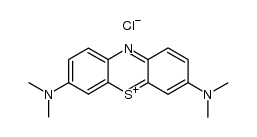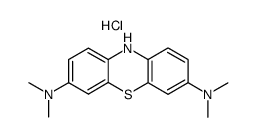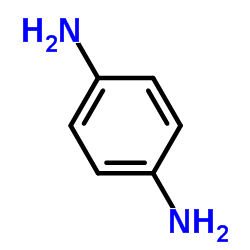Thionine

Thionine structure
|
Common Name | Thionine | ||
|---|---|---|---|---|
| CAS Number | 581-64-6 | Molecular Weight | 263.746 | |
| Density | 0.983g/cm3 | Boiling Point | 271.606ºC at 760 mmHg | |
| Molecular Formula | C12H10ClN3S | Melting Point | N/A | |
| MSDS | N/A | Flash Point | 85.966ºC | |
Use of ThionineThionin chloride is a coloring agent. |
| Name | thionine |
|---|---|
| Synonym | More Synonyms |
| Density | 0.983g/cm3 |
|---|---|
| Boiling Point | 271.606ºC at 760 mmHg |
| Molecular Formula | C12H10ClN3S |
| Molecular Weight | 263.746 |
| Flash Point | 85.966ºC |
| Exact Mass | 263.028381 |
| PSA | 91.00000 |
| LogP | 3.94570 |
| Index of Refraction | 1.479 |
| Water Solubility | H2O: 1 mL/vial clear to slightly hazy, colorless solution |
Synonym:3,7-Diaminophenothiazin-5-ium Chloride; Katalysin; Thionine Section 2 - COMPOSITION, INFORMATION ON INGREDIENTS
Risk Phrases: None Listed. Section 3 - HAZARDS IDENTIFICATION EMERGENCY OVERVIEW
The toxicological properties of this material have not been fully investigated. Potential Health Effects Eye: This product contains a cationic dye. Similar dyes have caused permanent injury to the cornea and conjunctiva in documented exposure cases with human or rabbit eyes. Skin: May cause skin irritation. The toxicological properties of this material have not been fully investigated. Ingestion: May cause irritation of the digestive tract. The toxicological properties of this substance have not been fully investigated. Inhalation: May cause respiratory tract irritation. The toxicological properties of this substance have not been fully investigated. Chronic: No information found. Section 4 - FIRST AID MEASURES Eyes: Get medical aid. Do NOT allow victim to rub eyes or keep eyes closed. Extensive irrigation with water is required (at least 30 minutes). Skin: Immediately flush skin with plenty of water for at least 15 minutes while removing contaminated clothing and shoes. Get medical aid if irritation develops or persists. Wash clothing before reuse. Ingestion: Never give anything by mouth to an unconscious person. Get medical aid. Do NOT induce vomiting. If conscious and alert, rinse mouth and drink 2-4 cupfuls of milk or water. Inhalation: Remove from exposure and move to fresh air immediately. If not breathing, give artificial respiration. If breathing is difficult, give oxygen. Get medical aid if cough or other symptoms appear. Notes to Physician: Section 5 - FIRE FIGHTING MEASURES General Information: As in any fire, wear a self-contained breathing apparatus in pressure-demand, MSHA/NIOSH (approved or equivalent), and full protective gear. Dusts at sufficient concentrations can form explosive mixtures with air. Combustion generates toxic fumes. During a fire, irritating and highly toxic gases may be generated by thermal decomposition or combustion. Extinguishing Media: Use agent most appropriate to extinguish fire. Use water spray, dry chemical, carbon dioxide, or appropriate foam. Section 6 - ACCIDENTAL RELEASE MEASURES General Information: Use proper personal protective equipment as indicated in Section 8. Spills/Leaks: Vacuum or sweep up material and place into a suitable disposal container. Clean up spills immediately, observing precautions in the Protective Equipment section. Avoid generating dusty conditions. Remove all sources of ignition. Provide ventilation. Section 7 - HANDLING and STORAGE Handling: Wash thoroughly after handling. Remove contaminated clothing and wash before reuse. Use with adequate ventilation. Minimize dust generation and accumulation. Avoid contact with eyes, skin, and clothing. Keep container tightly closed. Avoid ingestion and inhalation. Storage: Store in a tightly closed container. Keep from contact with oxidizing materials. Store in a cool, dry, well-ventilated area away from incompatible substances. Section 8 - EXPOSURE CONTROLS, PERSONAL PROTECTION Engineering Controls: Facilities storing or utilizing this material should be equipped with an eyewash facility and a safety shower. Use adequate ventilation to keep airborne concentrations low. Exposure Limits CAS# 581-64-6: Personal Protective Equipment Eyes: Wear appropriate protective eyeglasses or chemical safety goggles as described by OSHA's eye and face protection regulations in 29 CFR 1910.133 or European Standard EN166. Skin: Wear appropriate protective gloves to prevent skin exposure. Clothing: Wear appropriate protective clothing to prevent skin exposure. Respirators: Follow the OSHA respirator regulations found in 29 CFR 1910.134 or European Standard EN 149. Use a NIOSH/MSHA or European Standard EN 149 approved respirator if exposure limits are exceeded or if irritation or other symptoms are experienced. Section 9 - PHYSICAL AND CHEMICAL PROPERTIES Physical State: Solid Color: black-green Odor: None reported pH: Not available. Vapor Pressure: Negligible. Viscosity: Not available. Boiling Point: Not available. Freezing/Melting Point: Not available. Autoignition Temperature: Not applicable. Flash Point: Not applicable. Explosion Limits, lower: Not available. Explosion Limits, upper: Not available. Decomposition Temperature: Not available. Solubility in water: Soluble in water. Specific Gravity/Density: Not available. Molecular Formula: C12H10N3SCl Molecular Weight: 263.6031 Section 10 - STABILITY AND REACTIVITY Chemical Stability: Stable under normal temperatures and pressures. Conditions to Avoid: High temperatures, incompatible materials, dust generation. Incompatibilities with Other Materials: Oxidizing agents. Hazardous Decomposition Products: Hydrogen chloride, carbon monoxide, oxides of nitrogen, oxides of sulfur, irritating and toxic fumes and gases, carbon dioxide. Hazardous Polymerization: Has not been reported. Section 11 - TOXICOLOGICAL INFORMATION RTECS#: CAS# 581-64-6: SN5425000 LD50/LC50: Not available. Carcinogenicity: Thionin - Not listed by ACGIH, IARC, or NTP. Other: See actual entry in RTECS for complete information. Section 12 - ECOLOGICAL INFORMATION Section 13 - DISPOSAL CONSIDERATIONS Dispose of in a manner consistent with federal, state, and local regulations. Section 14 - TRANSPORT INFORMATION IATA Not regulated as a hazardous material. IMO Not regulated as a hazardous material. RID/ADR Not regulated as a hazardous material. Section 15 - REGULATORY INFORMATION European/International Regulations European Labeling in Accordance with EC Directives Hazard Symbols: Not available. Risk Phrases: Safety Phrases: S 24/25 Avoid contact with skin and eyes. S 28A After contact with skin, wash immediately with plenty of water. S 37 Wear suitable gloves. S 45 In case of accident or if you feel unwell, seek medical advice immediately (show the label where possible). WGK (Water Danger/Protection) CAS# 581-64-6: No information available. Canada CAS# 581-64-6 is listed on Canada's DSL List. CAS# 581-64-6 is not listed on Canada's Ingredient Disclosure List. US FEDERAL TSCA CAS# 581-64-6 is listed on the TSCA inventory. SECTION 16 - ADDITIONAL INFORMATION N/A |
CHEMICAL IDENTIFICATION
HEALTH HAZARD DATAACUTE TOXICITY DATA
MUTATION DATA
|
| Hazard Codes | Xn: Harmful; |
|---|---|
| Risk Phrases | 36/37/38-42 |
| Safety Phrases | S22-S24-S26-S36/37 |
| WGK Germany | 2 |
| RTECS | XO8950000 |
|
~% 
Thionine CAS#:581-64-6 |
| Literature: Spectrochimica Acta - Part A: Molecular and Biomolecular Spectroscopy, , vol. 81, # 1 p. 228 - 235 |
|
~% 
Thionine CAS#:581-64-6 |
| Literature: Spectrochimica Acta - Part A: Molecular and Biomolecular Spectroscopy, , vol. 81, # 1 p. 228 - 235 |
|
~% 
Thionine CAS#:581-64-6 |
| Literature: Journal de Chimie Physique et de Physico-Chimie Biologique, , vol. 52, p. 626,630 |
|
~% 
Thionine CAS#:581-64-6 |
| Literature: Journal of Physical Organic Chemistry, , vol. 12, # 3 p. 194 - 200 |
| Precursor 3 | |
|---|---|
| DownStream 0 | |
| FACTOR IIA |
| 3H-Phenothiazin-7-amine, 3-imino-, monohydrochloride |
| lauthschesviolett |
| THROMBIN |
| FIBRINOGENASE |
| katalysin |
| approx.dyecontent |
| 3,7-Diamino-phenothiazinylium,Chlorid |
| MFCD00082072 |
| 3-Imino-3H-phenothiazin-7-amine hydrochloride (1:1) |
| Thionin hydrochloride |
| 3H-Phenothiazin-7-amine, 3-imino-, hydrochloride (1:1) |
| 3H-PHENOTHIAZINE, 7-AMINO-3-IMINO-, MONOHYDROCHLORIDE |
| EINECS 232-648-7 |
| 3,7-diamino-phenothiazinylium,chloride |
| 3H-Phenothiazin-7-amine, 3-imino, monohydrochloride |
| EC: 3.4.21.5 |



